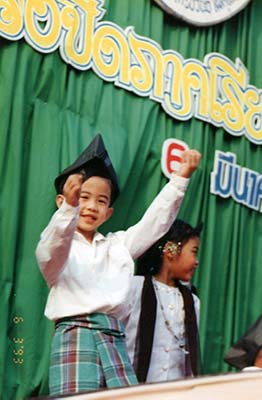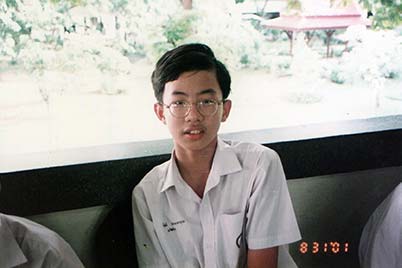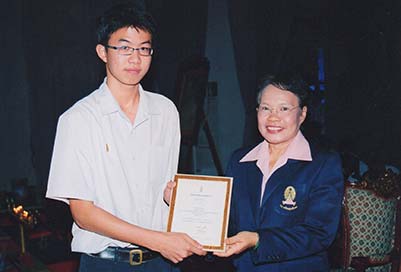

Many people often ask me, "Was your childhood full of intense studying? How did you study? How did you become so good at math that you became a representative for the International Math Olympiad?"
But I want to clarify that I wasn't the studious child that most people imagine. I never got a 4.00 GPA, and I wasn’t good at every subject. My strengths were only in math, physics, and science-related subjects. For Thai language and social studies, I mostly got a 3, and I barely passed the exams.

I studied at Kasetsart University's Demonstration School, Bangkhen. Math had been my strong subject since I was young. I remember in 4th grade, I loved reciting multiplication tables and practicing fast multiplication on my own, without anyone pushing me. It felt like a challenge to get the answers correct and become quicker each time. I also enjoyed playing the 24 game, chess (both Thai and international versions), and I played nearly every day during lunch.
After school, I’d run around with friends, play marble shooting, and towards the end of elementary school, I started playing basketball. During elementary school, there wasn’t anything remarkable about me; I was just an average student who was good at math but not the best. When I competed in math contests, I only won consolation prizes. Apart from school, my father bought me a small math workbook, but I never finished it. I didn’t focus much on academic tutoring; instead, I mainly took lessons in music and sports.

Thanks to my solid grasp of addition, subtraction, multiplication, and division, I had no trouble with math in middle school. However, my performance in competitions remained average, and I didn’t think of myself as exceptionally smart. I remember a friend once said, “Lim, you’re only good at math,” and it was true.
During middle school, I was obsessed with sports, particularly basketball. I practiced every evening until 7 p.m., and by the time I got home, I barely did my homework, only doing the minimum to finish it. I didn’t do additional math tutoring either. Although my father tried to push me to work on math exercises daily, I seldom did them.
Although I didn’t devote much time to math in middle school, I always questioned every new thing I learned. I constantly wondered why things had to be that way, and I would try solving problems differently than the examples given or proving concepts on my own to reduce what I needed to memorize. I learned by reading, as I couldn’t learn well by listening to teachers explain things (even when I tried to listen attentively, I still didn’t get it). As a result, most of my time at school was spent playing with friends rather than paying attention in class. My notebooks were always empty, except when the teacher insisted that I take notes. Looking back, I believe this habit became an advantage in learning mathematics.
Math requires spatial reasoning and visualization more than auditory skills (at least in algebra). It also requires the ability to learn independently, especially when tackling problems beyond what the teacher has taught.
This self-learning approach and constant reading helped me strengthen my skills. I never gave up on challenging problems, sometimes spending days on a single question until I found the answer. Every problem I solved had to be fully understood from every angle, whether it was my own method or a more efficient one.
I never focused on shortcuts and memorized the fewest formulas possible. Perhaps my memory isn’t great, but when I do remember something, it stays with me for a long time. Even now, I still remember theorems I learned in high school.
Having the opportunity to create theMYMATH, I’ve tried to instill the idea of self-learning in students. We encourage them to understand examples, use hints, work on exercises, and try solving problems on their own. When they succeed, they feel proud and confident in tackling more difficult problems independently, without giving up on unfamiliar challenges.
After middle school, I took the entrance exam for Triam Udom Suksa School, although I hadn’t planned on it initially and didn’t prepare at all. I attended a single tutoring session before the exam because a friend who decided not to take the exam offered me their spot in the class. Surprisingly, I passed with a good rank, probably because of my strong math skills and the difficulty of the math questions. My friends who also passed encouraged me to attend Triam Udom.

Once I got into Triam Udom Suksa in the Gifted Math (Gifted Math Generation 1) program, I met many brilliant peers, and it felt like the world had suddenly expanded. Many students had studied ahead, but I hadn’t, so I spent the first semester of 10th grade reading math books from grades 10 to 12 and even university-level calculus on my own. I used time during other classes to read math instead of listening to the teachers. After school, I still played basketball with friends. I attended some tutoring classes but didn’t take extra math lessons.
I’m not suggesting that this learning method is the best for every student, but it worked for me. Self-learning, understanding examples, and working on challenging exercises built a solid foundation in math. It made me accurate, fast, and thorough. The advantage of being at Triam Udom, compared to Kasetsart University's Demonstration School, was having extremely talented peers who constantly kept me alert. The exams at Triam Udom were tough (many people mistakenly think Triam Udom has the best teaching, but I believe it’s simply one of the schools with the most talented students and the hardest exams, forcing students to study on their own). There was also the Chulalongkorn University Bookstore nearby, with a wealth of materials. I had many test prep books and completed several of them. The collection of math problems from Triam Udom, with over 100-200 questions per chapter, was also fully solved.
I practiced a large number of high school-level math problems (probably many times more than the average student). This practice wasn’t forced; I enjoyed it. For me, the fun in math lies in solving problems that initially seem difficult. I saw math as a game, where the reward was the satisfaction of figuring out the solution. Many people who enjoy math share this feeling, while those who dislike it may never have experienced the pride of solving a problem on their own.
This is why, at theMYMATH, we try to build a strong foundation for students by encouraging them to learn independently. This solid foundation helps them tackle problems at or above their level. When they succeed, it boosts their confidence and pride, allowing them to continue progressing in their math journey.
Lastly, this isn’t to say that everyone needs to be good at math, or that being good at math guarantees success. I just wanted to share my own learning approach from when I was younger. If any readers are interested in self-learning and practicing math through solving a large number of problems, feel free to contact us for more information about our system.
Explore how mastering basic arithmetic lays the groundwork for success in advanced math through the life experience of our famous tutor.